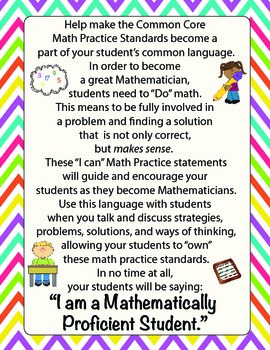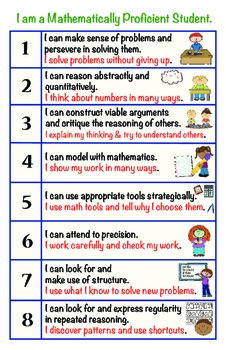Mathematical Practice Standards - Kid Friendly "I Can..." Statements
Two Snappy Gingers
216 Followers
Grade Levels
K - 6th
Subjects
Resource Type
Standards
CCSSMP1
Formats Included
- PDF
Pages
7 pages
Two Snappy Gingers
216 Followers
Description
Help make the Common Core Math Practice Standards become a part of your student’s common language.
In order to become a great Mathematician, students need to “Do” math. This means to be fully involved in a problem and finding a solution that is not only correct, but makes sense.
These “I can” Math Practice statements (from the 8 Mathematical Practices Standards, CCSSM) will guide and encourage your students as they become Mathematicians.
Use this language with students when you talk and discuss strategies, problems, solutions, and ways of thinking, allowing your students to “own” these math practice standards. In no time at all, your students will be saying: "I'm a Mathematically Proficient Student"
Included in this bulk file are Individual statement cards (2 up on an 8.5x11) to be cut in half, and an 11x17 class poster.
(The poster can also be printed on an 8.5x11 page for class notebooks)
In order to become a great Mathematician, students need to “Do” math. This means to be fully involved in a problem and finding a solution that is not only correct, but makes sense.
These “I can” Math Practice statements (from the 8 Mathematical Practices Standards, CCSSM) will guide and encourage your students as they become Mathematicians.
Use this language with students when you talk and discuss strategies, problems, solutions, and ways of thinking, allowing your students to “own” these math practice standards. In no time at all, your students will be saying: "I'm a Mathematically Proficient Student"
Included in this bulk file are Individual statement cards (2 up on an 8.5x11) to be cut in half, and an 11x17 class poster.
(The poster can also be printed on an 8.5x11 page for class notebooks)
Total Pages
7 pages
Answer Key
N/A
Teaching Duration
N/A
Report this resource to TPT
Reported resources will be reviewed by our team. Report this resource to let us know if this resource violates TPT’s content guidelines.
Standards
to see state-specific standards (only available in the US).
CCSSMP1
Make sense of problems and persevere in solving them. Mathematically proficient students start by explaining to themselves the meaning of a problem and looking for entry points to its solution. They analyze givens, constraints, relationships, and goals. They make conjectures about the form and meaning of the solution and plan a solution pathway rather than simply jumping into a solution attempt. They consider analogous problems, and try special cases and simpler forms of the original problem in order to gain insight into its solution. They monitor and evaluate their progress and change course if necessary. Older students might, depending on the context of the problem, transform algebraic expressions or change the viewing window on their graphing calculator to get the information they need. Mathematically proficient students can explain correspondences between equations, verbal descriptions, tables, and graphs or draw diagrams of important features and relationships, graph data, and search for regularity or trends. Younger students might rely on using concrete objects or pictures to help conceptualize and solve a problem. Mathematically proficient students check their answers to problems using a different method, and they continually ask themselves, "Does this make sense?" They can understand the approaches of others to solving complex problems and identify correspondences between different approaches.





